Ventilation in a clothes closet: features of arranging a hood in a dressing room and closet
In modern apartments with a large area, living conditions are more comfortable.Here you can easily allocate space for arranging a dressing room or installing a large closet for storing clothes, shoes, and accessories.
Modern wardrobes are huge in size and can accommodate a huge amount of things. And the created wardrobes sometimes reach entire rooms in size. To ensure high-quality safety of things, it is necessary to create special storage conditions, including a properly equipped air exchange system.
In this article we will talk about how ventilation should be arranged in a wardrobe and what features should be taken into account. We will select visual photos about hoods in the dressing room and useful video tips.
The content of the article:
Why do you need ventilation in the dressing room?
Despite the size of the dressing room, it is still a room without free access to air. And in closed conditions and lack of air circulation, bacteria can develop, fungus and mold.
To prevent such a situation, in southern countries, for example, storing things in a confined space is allowed only after they have been washed. Otherwise, a humid, hot climate and lack of air circulation have a beneficial effect on the development of mold on clothing that has come into contact with the human body at least once. Thus, one worn shirt can cause mold to cover all the clothes in an unventilated area.
In the climatic conditions of our country, the development of mold can be facilitated by wet or dirty clothes thrown into a closet or wardrobe. For example, a tracksuit after a run.
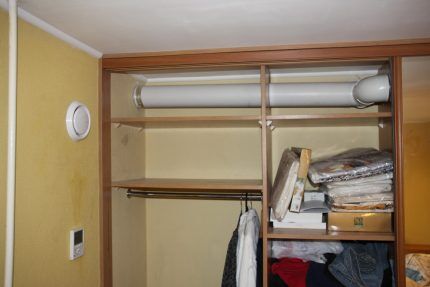
However, mold and mildew are not the worst things that can form in the confined space of a closet or dressing room.
The absence of a hood in a dressing room or closet contributes to the appearance of:
- Moli - an insect that grinds fur into powder, using fur fibers as food.
- Kozheedov, which feed on leather products and are capable of chewing holes in clothing the size of a five-ruble coin. When skin beetles appear, the only way to get rid of them is to completely disinfest the apartment.
- Cockroaches. Oddly enough, they are attracted not by crumbs and scraps, but by the smell of a person. Human sweat, various food stains on clothes and starch, which is used when washing things, serve as excellent bait for cockroaches. As they eat it all, they leave many small mesh holes on the fabric.
- Silverfish. They are also attracted to the smell of human sweat. When they eat it, they leave many small holes in the clothes.
- Sverchkov. It would seem that these are completely harmless insects, but they, like cockroaches, eat fabric along with sweat and food debris on clothing. It is almost impossible to remove crickets on your own.
We must always remember that parasitic microorganisms take every opportunity to settle in a person’s home.
Stagnant air in a confined space is a catalyst for the development of tiny parasites that will negatively affect human health, negatively affecting well-being, causing respiratory diseases or headaches.
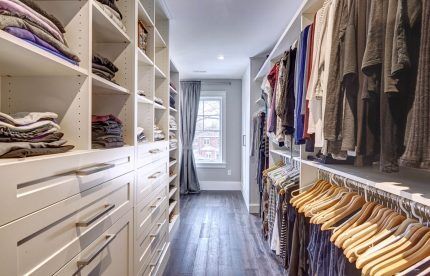
And, of course, the lack of ventilation affects the clothes themselves. The musty smell of an unventilated room is absorbed by the fabric and can only be removed after repeated washing.
Therefore, when deciding whether ventilation is needed in your dressing room and closet, it is worth considering the likely consequences of its absence. After all, it is the hood that ensures the normal condition of clothes, prevents the formation of parasites, mold and insects, and maintains a stable state of health for users.
Features of ventilation arrangement
Depending on the location of the dressing room or closet, as well as the presence or absence of a ventilation duct system installed during the construction of the house, the method of organizing air exchange will depend. Next, we will consider the options that are most popular among users.
Option #1 - natural ventilation
When installing cabinets, you should pay attention to the presence of windows in the room - regular ventilation provides an influx of fresh air, which will have a beneficial effect on the sanitary condition inside the room.In this case, you should systematically open the cabinet doors to organize air exchange. Such household ventilation will be quite sufficient for cabinets, and additional ventilation will not be needed.
We recommend that you familiarize yourself with the features of the arrangement natural ventilation.
It is worth noting that modern double-glazed windows create a tightness in the room, thereby preventing the flow of air through the window cracks. In such rooms, it is imperative to provide constant ventilation by opening the windows.
However, dressing rooms are usually located in “dead” parts of the apartment, where there is no access to fresh air. Therefore, it is so important to resolve the issue of ventilation in it even at the stage of arranging a dressing room without a single window.
Ventilation system in a dressing room without a window
In rooms where there is no window and there are no special ventilation openings with adjacent rooms, air flows will not be able to circulate naturally. With natural air circulation in the apartment, the standards provide for its movement from open windows to ventilation ducts, which are usually located in the bathroom, toilet and kitchen. Thus, air currents will bypass the closed dressing room, leaving it with an unpleasant odor and a favorable environment for the development of bacteria, parasites and insects.
The difference in air temperature in the enclosed dressing room and in the rest of the apartment can contribute to the appearance of condensation and further mold formation. And the absence of a hood in the dressing room leads to negative consequences.

In such rooms, in order to organize normal air movement with natural ventilation, it will be necessary to install a system of air ducts and openings between the walls. Through such openings, air from other rooms can penetrate and circulate inside the dressing room.
But, if the walls of the dressing room are in contact with the walls of a neighboring apartment or with rooms where there are no windows, then only the presence of an exhaust duct can ensure air circulation.
Ventilation in a dressing room with a window
Now let’s talk about how to properly make a ventilation system in a dressing room with windows. So, when installing a cabinet in such a room, it is enough to make several special holes for natural ventilation. Often, furniture manufacturers do not pay attention to this issue at all, preferring the originality of the design and decor of the cabinet to its normal functioning.
And just a few holes in the back wall of the cabinet will save the owner not only from the unpleasant musty smell of a confined space, but also from the appearance of the above-mentioned insects, fungi and mold.
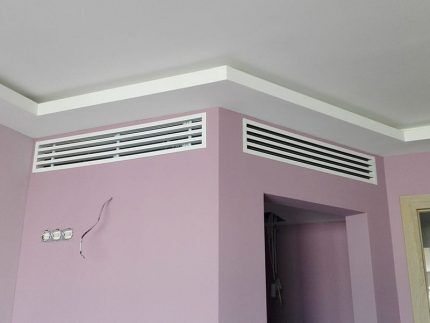
Option #2 - forced air exchange
To organize forced air exchange in a separate dressing room, you will have to install a separate ventilation duct, if one was not provided for during the construction of the apartment building.
[adinserter name=”desktop: insert in text – 6″]It is worth noting that modern apartment buildings are designed with the possibility of creating dressing rooms in which a general building ventilation system has been prudently installed.
The air flow is usually carried out through the bedroom, living room and other rooms where there are windows. And, the hood, accordingly, is installed in other rooms.
We discussed in detail the operating principles and rules for constructing a supply and exhaust ventilation system in this material.
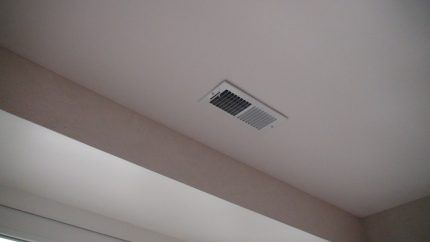
Using an exhaust fan
An additional method that will provide forced ventilation in the dressing room is to install a fan in the ventilation ducts, which will mechanically circulate fresh air inside the enclosed room.
To find out how much power a fan needs, just do some small calculations. To do this, calculate the volume of the room by multiplying the area of the dressing room by the height. The resulting value, multiplied by 1.5, will give us the air exchange rate per hour for this room.
Accordingly, the fan power must be selected based on the obtained values.
Installation of a wall ventilation valve
This arrangement of the dressing room, when only one room will be an adjacent room, will not make it possible to connect supply and exhaust ventilation. Currently, this problem can be solved by installing a supply valve into the wall.
[adinserter name=”desktop: insert in text – 7″]This device is a plastic pipe that supplies air from the street directly to the dressing room.

The supply valve includes the following elements:
- external ventilation grillewhich prevents moisture, dirt, large solid particles, and insects from entering the structure;
- filter, which cleans the outside air from small particles, directing purified air into the dressing room;
- valve, which allows you to smoothly regulate the power of air supply to the room.
More expensive models have a noise absorption system, automatic humidity control, and a special design where air coming from the street through a damper enters the radiator, where it is heated to room temperature, and then enters the dressing room.
[adinserter name=”desktop: insert in text – 8″]The installation of a wall ventilation valve should be done by a specialist, since the outer part will be installed at a certain height. Work at height must be carried out in compliance with all safety requirements.
Don't want to hire a professional to install a wall valve? In this case, we recommend that you read installation instructions.
Recommendations for arranging a hood
There are several types of dressing rooms. And the method of arranging ventilation will depend on their design features and location in the house or apartment.
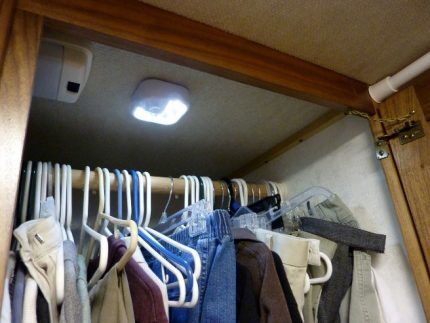
Let's consider the main types of dressing rooms and ways to ensure normal air exchange for them:
- Dressing room in a separate room. If the room does not have a window, then it is necessary to carry out supply and exhaust ventilation or install a wall valve. Only in this way will it be possible to ensure normal air circulation in the entire dressing room.
- Dressing room in utility room. This is the most common type of dressing room. Here it is necessary to provide supply and exhaust ventilation, which should be strengthened with an additional installation fan, which will avoid the appearance of a musty smell and the spread of bacteria indoors.
- Dressing room behind the partition. This is a specially built plasterboard structure. If it is located in a room with a window, then to ensure natural ventilation it will be enough to make the required number of holes in the drywall, which can be decorated so as not to disturb the overall design of the room.If the structure is built in a room without a window (usually they are made in the corridor), then it is impossible to do without supply and exhaust ventilation, which will be provided with the help of an installed fan of the required power.
- Dressing room under the stairs. This is a fairly common option in private houses and two-story apartments. It is a large closet for storing various things. Ventilation can be organized in such a dressing room by making special ventilation holes in the internal walls into adjacent rooms. The air will circulate naturally.
- Corner cupboard. For this option, installing ventilation is a rather complicated operation. That is why special ventilation holes must be provided in the rear or side walls of the cabinet. It is advisable to additionally install decorative ventilation grilles into the doors of such cabinets.
Additionally, inside the dressing room or closet, you can install devices for monitoring the air condition, which will also control humidity.
[adinserter name=”desktop: insert in text – 9″]This measure will prevent the appearance of dampness and the spread of fungus on walls and clothing in advance.
Conclusions and useful video on the topic
This video shows how to properly design a dressing room:
This video presents ideas for ventilation in all rooms when renovating an apartment:
The installation procedure for supply ventilation is shown in the video below:
Organizing the ventilation of closets with clothes and dressing rooms is a measure that is necessary to create a healthy climate inside an apartment or house.The possibility of unpleasant odors, mold, mildew, and insects making the creation of ventilation in dressing rooms and closets a necessity, which will have a beneficial effect on health. Choosing the right option and proper organization of ventilation in storage areas will keep the air in your apartment clean and fresh.
Do you have any questions about the topic of the article? Or would you like to supplement the above material with useful comments? Questions and personal suggestions for arranging a hood in the dressing room can be left in the block located below the article.



